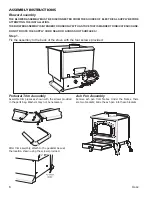
10
The room where the stove is placed must have an air inlet with a cross-section of at least 80 cm² so as to
guarantee sufficient air supply to the stove for combustion. Alternatively, the stove air may be taken directly
from outside through a 5 cm steel extension of the pipe. In this case, there may be condensation problems
and it is necessary to protect the air intake with a grille, which must have a free section of at least 12 cm². The
pipe must be less than 1 metre long and have no bends. It must end with a section
at 90° facing downwards or be fitted with a wind guard.
Smoke outlet:
It is forbidden to lead out the smoke from the stove directly thru the wall in the atmosphere. There must be
smoke pipe or chimney which will lead the smoke to a safety for the health height.
It is recommended to install the stove as closest possible to a chimney. This will reduce the need of smoke
connecting pipes.
The discharge system must only be used for the
stove (the chimney must not be used by other appliances).
The smoke goes thru 8 cm in diameter outlet at the back of the stove. T-junction connector with condensation
collector must be ensured and installed at the beginning of the vertical section.
The stove smoke discharge
must be connected with outside by means of steel or black pipes with certification
ЕN 1856. The pipes must be
hermetically sealed. The pipes must be isolated and sealed with heat resistant materials (
high temperature
silicone or mastic
).
The only horizontal section allowed may be up to 2 m long
.
The horizontal section must
have a minimum inclination of 3% and a maximum of two 90° bends. If the outlet is not fitted into a chimney
flue, a vertical section of at least 1.5 m will be required, complete with a wind guard. The vertical duct can be
internal or external. If the smoke channel is outside, it must be insulated.
If the smoke channel is fitted inside
a chimney flue, the latter must be suitable for solid fuel. If it is wider than 150 mm in diameter, a pipe must be
entered and the outlet sealed to the masonry. All sections of the smoke duct must be accessible for inspection.
At the bottom part of the chimney there should be a revision opening, allowing periodically cleaning, which
should be made at least once per year
. According to the existing standards at the top of the chimney pipe a
wind resistant element must be installed.
Picture 4
А: insulated steel chimney.
В: minimum height 1.5 m. Beyond the roof eaves.
С-Е: air inlet from outside (thru section of at least 80 сm
2
)
D: steel chimney in already existing masonry chimney.
Hydraulic connections
The stove is equipped with water boiler with capacity of 22 l. This significant amount of water, renders the
stove very smooth during operation. Also providing excellent burning process and excellent results.
WARNING!!! The stove must never be made to work without water in the system or at a pressure under 1
bar. If ignited without water in the system the stove can be heavily damaged.
All hydraulic connections must be completed by authorized specialists, which can issue a certificate. Other
check-ups can be also performed in accordance with the law and requirements valid for the country in which
the stove is used.
Practical notes:
1)
Consider appropriate solutions when connecting the supply water, return water and drain, which will
make more easy the moving of the stove if it is ever needed.
2)
To improve the work of the primary circuit (where there is a heat generator) must be separated from
the secondary.







































